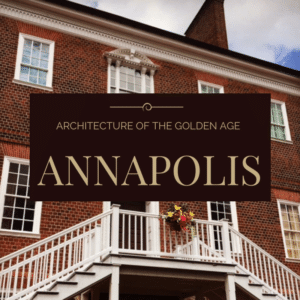A Virtual Tour through the “Golden Age” of Annapolis Architecture
 A Capital Beginning
A Capital Beginning
In 1694, The Maryland General Assembly voted to move the colony’s capital from St. Mary’s City to what was then called Anne Arundel Town. Thus was laid the foundations of Annapolis’ “golden age,” which lasted from the late 1750s to 1776.
The Town Plan
Governor France Nicholson created a new town plan in 1696, whose central concept of circles and squares were inspired by European urban design. The most prominent hills were reserved for buildings that represented state and church, the two pillars of colonial society – Maryland State House and St. Anne’s Church– with streets radiating from them to provide impressive vistas. The colony’s General Assembly first met at the State House in 1779. It remains the oldest state house in continuous legislative use in the county.
Architectural Heritage
The town continued to flourish and by the close of the “golden age,” more than 450 building had been constructed in Annapolis, including the James Brice House. During this time Annapolis gloried in its role as the center of politics and patronage, and the houses of plantation owners and politicians stood as evidence of their owners’ economic and social standing.
Architects and Craftsman
Among the names associated with Annapolis’ finest houses is William Buckland. An English designer, he came to American originally to work on George Mason’s residence, Gunston Hall, in Virginia. About 1772 Edward Lloyd hired him to work in Annapolis on what is now the Chase-Lloyd House. Two years later the young planter Matthias Hammond hired him to design the Hammond-Harwood House.
The town’s grandest houses were often set amid large gardens that mirrored the geometry of the house while serving both practical and decorative functions. Unfortunately, many of these have been lost over time. However, you can imagine their scope by visiting the William Paca House, where archaeological evidence has been used to reconstruct the landscape. Archeology has also uncovered evidence of slave life at the James Brice House and Charles Carroll House.
The exterior elegance of these houses was matched on the interior by carved details and the finest textiles, furniture, paintings, silver, glass, and china that Europe and America had to offer. As Annapolis’ reputation grew, craftsmen moved from the larger cities to serve the new consumer market. Soon, the gentry could buy their fine wares from local shops, such as those of cabinetmaker John Shaw, whose work is displayed at the Hammond-Harwood House.
After the “Golden Age”
Since the closing days of the “golden age,” many of the town’s historic buildings have changed hands, been altered, added to, or restored to their original appearance. Despite these changes, Annapolis’ historic fabric remains remarkably intact, thanks in large part to the historic preservation efforts that began as early as the 1880s. Today, the city’s historic core is a National Historic Landmark District protected by city ordinances and overseen by the Historic Preservation Commission.
There is still much to explore. Visit our page on Annapolis’ Golden Age, or take a self-guided or guided tour that will lead you past houses once filled with 18th century music, dancing, and talk of tobacco, politics, and revolution.
The above is an excerpt from “Discover Four Rivers: A History Explorer’s Guide.” If you are interested in obtaining the full publication, please give us a call at 410-222-1805 or email [email protected]

